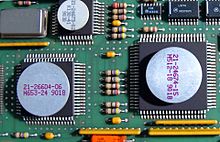CVAX
CVAX is a chipset that was developed by Digital Equipment Corporation (DEC) from 1984 to 1987, and subsequently manufactured and implemented the Virtual Address eXtension (VAX). The chipset was used exclusively in DEC computers such as the MicroVAX 3400 , MicroVAX 3100 Model 10/20 or the VAX 6000 Model 2/3 and was not available for other computer manufacturers. The 32-bit microprocessor included in the chipset was the first DEC processor to include an on -processor cache . In order to save chip space, the 1 KiByte cache for data and program code was implemented with dynamic RAM cells that only consist of one field effect transistor per bit.
construction
The chipset consists of a 32-bit microprocessor (CVAX 78034-CPU, 21-24674), which can be clocked with a maximum of 12.5 MHz , a floating-point unit called a floating-point accelerator (CFPA, 21-26604) , a clock chip CVAX clock chip and various peripheral chip such as the CVAX system Support chip (CSSC) , CVAX memory controller (CMCTL) and the CVAX Q-bus interface chip (CQBIC, 21-25972) .
The CVAX 78034-CPU consists of around 134,000 field effect transistors on a chip area of 9.7 mm by 7.4 mm. The processor was manufactured by DEC in a CMOS process with a structure width of 2 µm. It is housed in a CQFP-84 chip package . The processor is controlled by microcode and has a partial pipeline . The arithmetic unit comprises 16 generally usable registers, each 32 bit wide. A physical memory size of 1 GiByte and a virtual address space of 4 GiByte can be addressed.
The floating point processor (CFPA), initially designed as a separate chip, which is connected directly to the CVAX CPU via a special interface, consists of around 65,000 field effect transistors on a chip area of 7.3 mm by 9.1 mm. The CFPA is optimized for floating point operators like multiplication and division.
Shortly before the start of mass production of the CVAX chipset, at the end of 1987 a variant reduced in structure width to 1.5 µm was presented. This chipset, known as CVAX + or CVAX-60, could be operated with a higher clock rate of just over 16 MHz and was used in the then new VAX-6200 multi-processor computers in the following years. The last adjustment to the chipset was in 1990 the integration of the CFPA and the CVAX clock chip with an 8 KiByte L2 cache in one chip.
particularities
The development team placed various technically unnecessary symbols and texts on the CVAX 78034 CPU semiconductor chip. These elements are only visible after mechanical and chemical removal of the chip housing by means of thin sections and microscopic examination methods of the chip surface. Among other things, the representation of a hand in a poker game with the text in English $ ... The Dream Is Always The Same was attached to the semiconductor chip. This expressed the desire to be able to boot the OpenVMS operating system and to be shown the input prompt , which appears with a $ sign.
At that time, some semiconductor chips in the former Eastern Bloc were analyzed and reproduced identically, also known as reverse engineering . While the predecessor chipset MicroVAX 78032 was successfully copied by DEC as MME U80701 in the former GDR, this was no longer possible with the CVAX chipset due to the historical processes with the collapse of the Eastern Bloc. The replica of the CVAX 78034 planned as U80900 in the GDR was never realized.
Since the manufacturer was aware of the replicas in the Eastern Bloc, a text in Russian with Cyrillic characters was stored on the chip surface of the CVAX 78034 , which basically says: VAX - If you are good enough to steal the best .
Web links
- CVAX 78034 CPU , chip photo
Individual evidence
- ↑ a b c Bob Supnik: CVAX (1987). Retrieved August 14, 2013 .
- ↑ Thomas F. Fox et al .: The CVAX 78034 Chip, a 32-bit second-generation VAX microprocessor . In: Digital Technical Journal . No. 7 . Digital Equipment Corporation (DEC), company publication, August 1988, p. 95–108 (English, online [PDF; 9.7 MB ]).
- ^ The Dream. Retrieved August 15, 2013 .
- ^ Steal The Best. Retrieved August 15, 2013 .

